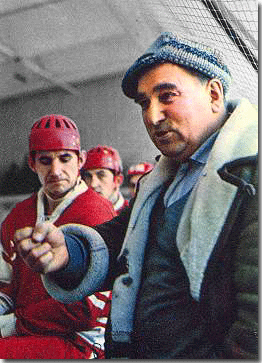Hockey’s pretty much a year-round sport these days. Finnish teams, for example, play their first exhibition games already in early August when the rest of the world is still at their barbecues. Today, the players seem to be in shape all the time, August or April, they’re no slackers, and the Mario Lemieux kind of training – “not ordering the fries with my sandwich” – has gone the way of the Bobby Hull toupee.
I’m with Mario, always have been, but still, summer always feels like a new chance to get in shape. I don’t seem to succeed, but every summer, I still try. I even do some of the old conditioning drills back from when I still could. And when nobody’s watching, I try to run up a tree. I always have to get at least three steps up the trunk to feel good about myself.

Back in 1984 or so, when I was a freshman in high school, our hockey hotbed town got visitors from the Soviet Union. We, my team, were told to report to practice on the tennis court of my high school for an off-season practice session, headed by Anatoli Tarasov, “the father of Russian hockey.”
There we were, all twenty or so of us, standing in line in the scorching sun, looking around to see what he wanted us to do, out of breath because we had just sprinted there, as told. Except for those three teammates of mine who took a shortcut and walked through a hole in the fence, instead of jumping over it, like we were supposed to.
Uncle Anatoli wasn’t happy. As a punishment for their laziness – and undoubtedly lack of character – the three players had to turn three somersaults right there on the asphalt.
No mercy.
After a little warm up, Mr. T led us to the lawn by the side of the schoolyard. We all stood in line, as he explained the drill to an interpreter who then told us what to do, and then retreated to the shade to observe.
“First, run up the trees here, everybody has to get in three steps, but try to do four,” he said. Only, he said it in Russian, so we just stood there, staring at him, waiting for the interpreter to do his job. And then we just stood there, staring at him, trying to figure out if he was being serious.
It was a birch, not huge, but solid enough to… well, be run on. None of us had ever done that so there was some nervous laughter.
“Then, you continue running and do three vaults,” he said.
We looked around at each other to see if we had understood the interpreter right. Or, even more so, if he had really understood Tarasov right. There was nothing there, just the lawn. Nothing to jump from – especially not skill – and no mats to land on.
“And then run back to the back of the line.”
I waited for my turn, took a deep breath and dashed towards the birch. One, two, three, up, up, up, and fourth, and down.
Jogged along to the next station and without thinking, without ever having done vaults before, I jumped and tried to do something in the air before landing on my back on the lawn.
I thought it was obvious that it was not only an impossible task, it was also idiotic to have young kids jumping on their backs on bare ground. But when Anatoli Vladimirovitch said “jump,” you said, “how high?”
After all, Tarasov was the man who once said that he saw two young players come to the practices, and without even seeing them play, he could tell which one of them would become a better player.
Naturally, it was the one who carried his own bag.
So, I took another deep breath, and jumped, twisted my 120-lb body every which way – and landed on my back. The pain was worse this time, but I still had to make one more attempt.
It took me a few years to realize that Tarasov wasn’t even trying to teach us to jump and do a vault.
He was trying to teach us to get up.

Good story, been there as one of those 20. :)